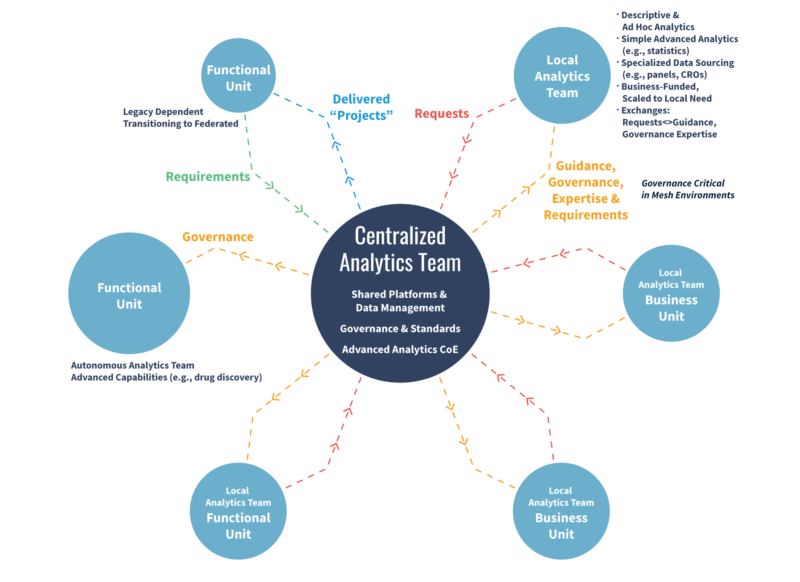
Over the past month, we’ve explored the promise and complexity of federated analytics. We started with the root problem: the exhausting oscillation between centralized and decentralized models. From there, we outlined what federation actually requires, how to resource it, and where to begin the transition.
If you’ve been following the series, you’ve now got a working blueprint and a set of strategies to move forward.
- Federated Analytics and Avoiding the Oscillation Trap
- Federated Analytics: Design Objectives and Operational Commitments
- Selling Federated Analytics for Resource Allocation
- Federated Analytics: Starting Blueprints and Transition Strategies
This article is about what goes wrong.
Because even with the right model in mind, many organizations still stumble. They focus on structure but ignore flow. They decentralize without direction. Or they build a federated vision, but forget to change how the work is funded, governed, and supported.
In this piece, I’ll walk through the most common pitfalls we see, the warning signs you’re drifting off course, and how to build a federated model that isn’t infatuated with how it looks on paper and actually works.

A Practical Guide to Building a Federated Analytics Operating Model
Use this practical guide to explore how a federated operating model can help complex enterprises balance autonomy with alignment, unlocking sustainable, enterprise-wide impact.
Common Pitfalls
When organizations decide to move toward a federated analytics model, the most common mistakes are rooted in the operations. The first big miss? Mistaking structure for change. Leadership redraws the org chart, shifts a few roles, maybe even rolls out a new “federated” vision. But if no one rethinks how work moves across the system—how teams collaborate, how products get built, how decisions are made—then the model hasn’t changed. Only the boxes on the page have.
The second failure is a lack of documented protocols. No roles, responsibilities, or expectations. No RACI diagrams. No standard operating procedures to help people understand what it means to be part of the central team versus the distributed one. No escalation or adjudication mechanisms for when things inevitably go sideways. Without these foundations, teams are left to improvise—and that improvisation quickly turns into inconsistency.
And then there’s the funding model. This is the quiet saboteur of most federated initiatives. You may talk about shared platforms and a unified analytics experience, but if business units still fund work in isolation, you’ll keep getting stovepiped solutions. One set of data products for marketing. Another for operations. Nothing integrated, nothing reusable. When that happens, it’s a clear signal: you didn’t change how anyone pays for the work. So, naturally, they didn’t change how they build it.
The downstream consequences show up quickly. You get a rash of unfunded mandates: “you must do this” without the resources to make it happen. Accountability becomes murky. Governance feels optional. People operate outside the guardrails because no one’s enforcing them. Coordination breaks down. Workarounds become the norm. The whole thing starts to look like chaos. And eventually, reversion kicks in. The system collapses back to centralization, or fragments into ad hoc distributed models. Either way, you’re right back in the oscillation trap—the exact thing you were trying to escape. And after all the effort it takes to stand up a federated model, that’s the last place you want to end up.
Warning Signs You’re Drifting Off Course
Even with the best intentions, federated models can quietly start drifting in the wrong direction. We’ve seen it happen more than once, especially when the language of federation is used as air cover for something else entirely.
A big red flag? The central team positions federation as a way to pull all those smart, capable local teams under tighter centralized control. That’s not federation. That’s a rebrand of recentralization—and it won’t work. You’ll know it’s happening if the most highly autonomous local teams are suddenly the first target in your restructuring. In a real federated model, they should be the last.
Another warning sign: too much emphasis on tooling and methods, not enough on data delivery. If your operating model conversation is dominated by platforms and templates, but you’re not actively roadmapping data products or accelerating delivery, you’ve lost the plot. Federation isn’t about stack rationalization. It’s about getting from raw data to business-ready insight faster, and doing it in a way that’s repeatable and scalable.
You should be measuring success by two key outcomes:
- Local decisions made at local speed
- A shift from 80% data wrangling and 20% insight delivery to the inverse—20/80
A more subtle but equally telling signal: you can’t fund foundational infrastructure. You know you need a new data engineering pipeline, or near-real-time tooling, but unless you find a project to drag it in, it’s dead in the water. That’s a classic sign that the funding model hasn’t caught up with your federated intent.
And finally, the most visible—and most politically volatile—warning sign: local analytics teams start going to outside vendors. That behavior will be noticed. Someone in the business will ask, “Why are we paying externally for something we should be able to do internally?” And that’s how you end up right back in the oscillator, with a new reorg looming on the horizon.

How to Avoid Common Pitfalls
So how do you avoid falling into the same traps?
It starts by recognizing that federation is about building shared discipline. The model only works when it’s both clear and enabling.
If your version of federation looks like local teams doing their own thing with the occasional sync meeting, you're not building a system—you’re just decentralizing by another name. You need guardrails. Invest in shared documentation. Build a catalog of data products, even if it’s imperfect. Establish SOPs and RACI diagrams that clarify who owns what. Frame the model as freedom within a framework, not “do what works for you.”
And don’t let governance turn into a control tower. We’ve seen teams use federation as a pretext to pull everything back to the center under the banner of “governance.” That’s not federation either. Embedded teams should have meaningful input into roadmaps, tooling, and standards. The central team’s job is to enable and not just enforce.
Community matters more than most people think. If analysts across the org don’t feel like part of a shared identity, they’ll retreat to their silos. Community curation shouldn’t be an afterthought. Make it someone’s job. Create internal forums. Celebrate local wins. Build connective tissue.
And don't overlook one of federation’s most powerful mechanisms: the MVP-to-product handoff. Local teams will create brilliant, business-specific solutions. But without a formal process to scale and harden those solutions, they stay stuck at the edge. Build a pipeline. Establish promotion criteria. Give credit where it’s due.
Finally—and critically—you need to fix the funding. You can’t run a new operating model on an old financial plan. Align your finance and analytics leaders. Shift from one-time project funding to portfolio-style investments. Make “run and maintain” part of the model. Otherwise, you’re just painting the walls while the foundation cracks underneath.
The truth is, most federated models don’t fail because the vision is wrong. They fail because the operational scaffolding isn’t there. But when it is? The model doesn’t just survive. It scales.
If you’re in the thick of making federation real—and facing questions about where to begin, how fast to move, or what to prioritize—you’re in good company. In our next webinar, I will sit down with Keith Moody, assistant vice president of analytics at Discount Tire, to walk through a real-world federated transition. IIA has supported Discount Tire in this transition, and from early wins to hard-earned lessons, this session will unpack what it really takes to bring the model to life. We’re looking forward to seeing you there!

What Every Enterprise Needs to Know about Federated Analytics
Explore our all-in-one resource hub for federated analytics models. Discover what a healthy federated analytics operating model looks like in practice, how to successfully transition to a federated approach, and much more. It's the full picture, in one place.